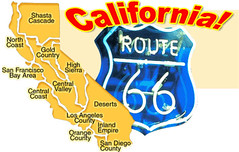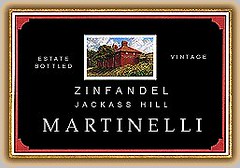
Only in California
California Wine Tasting, Take 3
My dislike for much of New World wine is due in a large part to years of careful tasting and analysis, but admittedly there is also a measure of prejudice and ignorance involved. As I live in a place where California wines represent a mere fraction of total sales (though this last year, it gained market share), I simply don’t have access to the many unique and less ‘main-stream’ wines that are being produced. As is so often the case, much of these wines either never make it out of the country, or aren’t big enough to join these traveling tasting carnivals.
So what defines great California? Who produces those wines which work that curious mix of terroir and winemaking style, pushing the envelope of what grapes can achieve within the parameters of the State; this is what interests me. Who are the models? I was confronted as expected by a multitude of wines that I would characterize as over-ripe and lacking acidity but, in general, I found the oak much less obtrusive and a movement amongst some towards a touch more austerity. Here are a couple of exemplary wines that, for different reasons, reveal the depth and complexity of what Cali can do.
Zinfandel 2000, Jackass Hill Vineyard, Russian River Valley, Martinelli
Guiseppe Martinelli’s wife named the vineyard saying that only a jackass would attempt to work this particular area of the family's property. The vineyard is on an almost 60-degree slope and typically yields one an
 d a half tons per acre (250 cases). Its southeastern exposure catches the early morning sun long before it reaches the vineyards on the valley floor and the afternoon’s sun is shaded by forested hills to the West. Helen Turly acts as winemaker and consultant.
d a half tons per acre (250 cases). Its southeastern exposure catches the early morning sun long before it reaches the vineyards on the valley floor and the afternoon’s sun is shaded by forested hills to the West. Helen Turly acts as winemaker and consultant.At 17.6% alchohol, it is aromatically closer to banyuls than a dry red, packed with layers of extremely ripe black plums and cassis. However, the shock is in that first taste. Slightly austere, waves of sweet spices (nutmeg, clove, pepper) were interwoven with luxurious fruit. As with most great wines, it inspired and while it worked wonders with the contre-filet, I could see it with a pan-seared fois gras in a spicy red wine sauce. Seghesio does Zinfandel really well (especially with its Vieilles Vignes and Carignan blend), but this is the reference.
Old Telegram 2003, Bonny Doon
While the jackass takes a classic Cali grape to another level, I liked this wine for its choice of grape. The relative monotony of Cab and Merlot is broken here with a 100% Mourvèdre offering from Randall Graham, inspired and named after my favorite Chateauneuf-du-Pape, Vieux Telegraph.
A notoriously late-ripener, Mourvèdre (curiously called Mataro on the label) works well in warm climates, and when done well can produce wines of depth and elegance that can rival some of the best Cabernet and Syrah. And this one does just that.
Again, this a wonderfully restrained wine which upon sticking my nose in the glass reminded me of cooking bacon on a balcony next to the ocean. Less gamey than meaty, it had an amazing balance between the hints of fruit and more characteristic notes of mushroom and pepper. Now this is a steak wine.
Estate Cuvée 2003, Paso Robles, L’Aventure
For the second year in a row I was lucky enough to find myself sitting next to Stephan Asseo at lunch. Check out Jathan’s article on Stephan for a full review of his wines.
Stephan has the honour of being the first California winemaker I have met who eschews the use of acidification in his wines. He works on a 2 ton/acre harvest with his vines planted at 2100 pied-acre. He recognizes the challenges posed by the heat of California summers which is why he is so big on the terroir of Paso Robles (soil and climate) which he claims allows his grapes to ripen with enough natural acidity to not need tweaking. While his whole line of wines combined Euro elegance while maintaining typical California ‘juiciness,’ the Estate Cuvée is this theme's apogee. A mix of 66% Cab, 28% Syrah and 6% Petit Verdot, the Estate combined ripe, chocolatized dark fruits with layers of spice, all held together with soft and impressive tannins.
But as we sat outside the hotel, puffing on a cigar (my first and possibly last), I got an insiders perspective on the some of the problems facing smaller, independent producers — most notably distribution. It is difficult to compete when larger companies can offer retailers and restaurants discounts and promotions that, if he matched, would undercut his already precarious margins. He is counting on more and more wine drinkers tiring of the ‘just good enough’ wines, and seeking out those winemakers who put the emphasis on expressing the individuality that comes from working the terroir, not the laboratory. Here’s to Stephan.
No comments:
Post a Comment